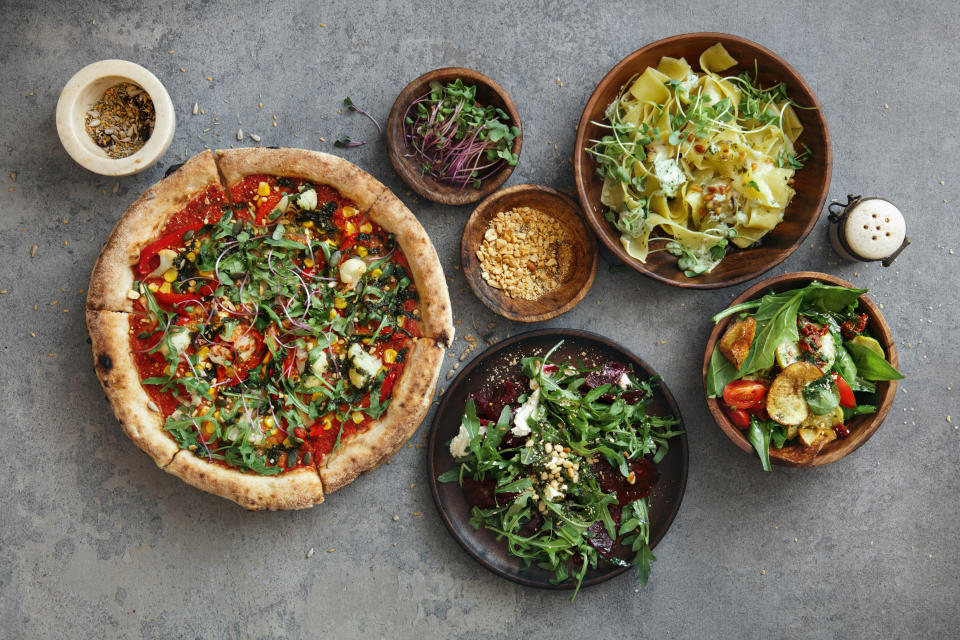Oftentimes, when we think about adopting a healthier approach to our diets, there is an assumption that we must sacrifice taste and enjoyment – that meals will consist of nothing more than nuts, legumes and berries.
And while these types of superfoods can really help boost our overall health, the key to maintaining a healthy lifestyle is balance. Therefore, it is recommended that you try to commit to realistic, everyday healthy eating habits, rather than try to change too much too soon – or pressure yourself into achieving unrealistic goals.
In fact, health coach Steve Bennett says the key to long-term success is making small, incremental – and consistent – changes.
Advertisement
Advertisement
He also stresses the importance of managing your insulin levels – aka, the hormone that regulates fat storage and the body’s fat levels.
“Each time you eat foods that spike your blood sugar (think bread, pasta, sweets), your body releases insulin to help lower that sugar. While insulin is high, your body is in ‘fat-storing mode,’ making it harder to lose weight,” he tells Yahoo UK.
“Lowering your insulin levels is key because, once they drop, your body can tap into stored fat as fuel. So, rather than focusing solely on calorie counting, think about how to manage insulin with these simple, actionable steps.”
6 simple healthy eating rules to follow
Bennett recommends the following ‘rules’ to help improve your overall diet:
1. Eat more fibre-rich foods
Having salad with a meal or before a meal can increase the amount of fibre in your diet. (Getty Images)
“Fibre is a game-changer when it comes to weight management,” Steve says. “It slows digestion, keeps you full for longer, and prevents insulin spikes that can lead to fat storage.”
Advertisement
Advertisement
“Start your meals with a handful of leafy greens or a fibre-rich salad – you can even try adding a fibre supplement to your morning routine,” he adds.
2. Avoid cereals
Close up top view of kid with afro hair eating breakfast in the morning. Healthy lifestyles.
Steve says: “Not only are a lot of cereals high, ultra-processed foods, but they are predominantly carbohydrates which turn into sugar.
“A sugar rush in the morning is the worst time to have one, as it puts you on a ‘carbo coaster’. In other words, a rush of carbs, insulin results in a crash and the body starts to demand more energy.”
Instead, Steve recommends starting the day with something that isn’t ultra-processed, such as scrambled eggs or tomatoes with sausages and bacon.
3. Skip sugary drinks
Try cutting out sugar from your morning coffee or reducing the amount of juice you drink. (Getty Images)
This one’s straightforward: fizzy drinks, juices and sweetened coffees are packed with sugar and can send your insulin levels skyrocketing.
Advertisement
Advertisement
More in Health
“Opt for water, sparkling water, or herbal teas instead,” Steve recommends. “Cutting out sugary beverages is an easy win that helps regulate insulin, while saving you unnecessary calories.”
4. Prioritise protein
Try incorporating more protein into your diet – whether that’s chicken, tofu, eggs or salmon. (Getty Images)
Advertisement
Advertisement
“Protein is a powerful tool in stabilising blood sugar and managing insulin,” explains Steve. “Adding a serving of protein to every meal – whether it’s eggs, chicken, fish, tofu, or even Greek yoghurt – can help keep you satisfied and prevent blood sugar spikes. Plus, protein helps preserve muscle mass, which is important for maintaining a healthy metabolism.”
5. Snack wisely
Savory pumpkin rosemary hummus with carrots.
Steve says that many snack foods are high in refined carbs, which can spike your blood sugar and insulin.
Instead, he suggests reaching for snacks that combine healthy fats, protein, and fibre.
“Nuts, seeds, veggie sticks with hummus, or a handful of roasted almonds are all great options,” he says. “These snacks won’t just keep you full – they’ll also help prevent blood sugar crashes.”
Advertisement
Advertisement
You may also benefit from preparing these snacks in advance, so that they’re ready to eat when your cravings or hunger strike.
6. Choose low-glycaemic carbs
Yep – you can still have bread! (Getty Images)
While you don’t have to completely cut out carbs, swapping refined carbs for whole, lower-glycaemic options can make a significant difference in how your body manages insulin, Steve suggests.
“Try replacing white bread with whole-grain bread or swapping pasta for spiralised courgette or cauliflower rice. These swaps are not only good for keeping insulin low, they’re often more nutrient-dense too.”
Read more on healthy foods and nutrition
EMEA Tribune is not involved in this news article, it is taken from our partners and or from the News Agencies. Copyright and Credit go to the News Agencies, email news@emeatribune.com Follow our WhatsApp verified Channel





